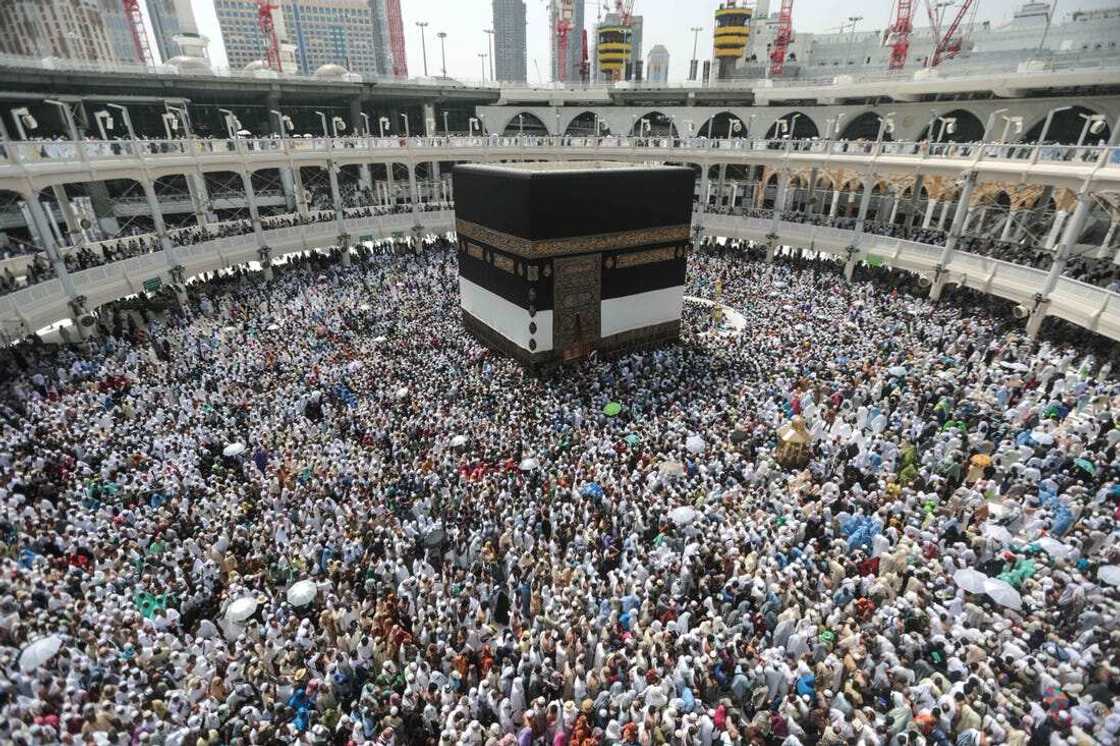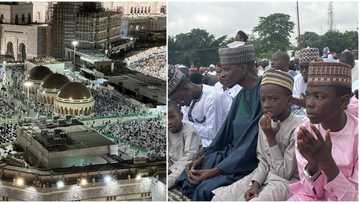What is Hajj? A Step-By-Step Guide to Muslim Pilgrimage
Year in and year out, Muslims around the world gathered in Mecca to perform Hajj, a pilgrimage said to be sacred to Muslims.
Hajj is an obligatory act for every Muslim able-bodied adult, who are as well, have the financial means to perform after Prophet Muhammad’s “farewell pilgrimage” in 632 AD, Aljazeera reported.

Source: Facebook
The Islamic tradition explained that the Kaaba, a black silk-clad stone structure, at the Grand Mosque in Mecca, was originally built by Prophet Abraham and Ishmael, his son.
All you need to know about Hajj
Yearly participants in the hajj activities are between two and three million who come together across the world for the tradition.
PAY ATTENTION: Join Legit.ng Telegram channel! Never miss important updates!
The Hajj ritual consisted of spiritual, emotional, and physical challenges with a test on the patience and temperament of the pilgrims.

Read also
Davido performs at 2023 Juneteenth commemoration with the US vice president in attendance: "OBO is doing well"
Hajj pilgrimage often happened between six days in Dhul-Hijjah, the 12th month of the Islamic lunar calendar, and between the eighth and 13th day of the month.
The 2023 Hajj is taking place between June 26 and July 1.
Below is the step-by-step guide to the rituals that will be performed during Hajj:
Day One
Intent and ihram: The number one Hajj rite is to make a pure intention and then enter the ihram, the pilgrim's sacred state. It is called Miqat when crossing the outer boundaries of Mecca.
To enter the ihram, the pilgrim has to put on plain garments (two unstitched pieces of cloth for men and loose-fitting clothing for women). They are expected to follow certain rules such as not getting angry or engaging in sexual activities.
Tawaf will then follow. Tawaf means circling the Kaaba in an anticlockwise direction seven times, and sai refers to running between the Safa and Marwa hills.
Mina, the tent city, After that, the pilgrims travel by foot on pilgrim paths or take a bus for the 8km (five-mile) journey to Mina, a tent city just outside of Mecca.
The pilgrims spend the day in Mina, setting out the next morning at dawn. Most of the time in Mina is spent in prayer, supplications, and remembering Allah (God).
Day Two
Arafat: The Day of Arafat is considered one of the most important days, not just of Hajj, but of the Islamic calendar. After making the 15km (nine-mile) journey from Mina, pilgrims spend the day at Mount Mercy in reverent prayer.
This is known as waqf, the act of standing before Allah from noon to sunset.
The site is particularly revered as the place where the Prophet Muhammad delivered his last sermon.
Across the world, Muslims are encouraged to fast on this day.
Muzdalifah: After sunset, it is time to move again, this time to Muzdalifah (an 11km, 7-mile) trip – where the pilgrims will spend the night under the stars. Many also begin collecting 49 pebbles here for the next day’s rites, for which they will depart again just before sunrise.
Day three
Nahr and stoning the devil (rami): The 10th of Dhul-Hijjah is Eid al-Adha, a day celebrated by Muslims around the world as the greater of the two Muslim holidays.
Leaving Muzdalifah, the pilgrims arrive back in Mina before dawn to perform the first rami, throwing seven pebbles at the largest of three columns known as Jamarat al-Aqaba.
This act is a symbolic stoning of the devil, based on historical tradition. Muslims believe that God told Abraham to sacrifice his son as proof of his faith.
It is believed that at this spot in Mina, the devil appeared and tried to dissuade Abraham from heeding the command. Abraham responded by throwing stones to scare him off.
Muslim pilgrims should also sacrifice an animal, known as nahr. Either a camel or lamb is suitable, and the meat should be distributed to the needy. Pilgrims can either buy sacrifice coupons/vouchers, which state that the sacrifice has been made on their behalf, or perform their own sacrifice.
Days four and five
The act of throwing stones is repeated for the next two days, pelting the three pillars using seven pebbles each in order by starting with Jamarat al-Ula (the small pillar), then Jamarat al-Wusta (the second/middle pillar) and finally, Jamarat al-Aqaba (the third/large pillar).

Read also
They are becoming restless: Tension as Hajj-bound pilgrims are stranded in Lagos airport for 4 days
Day six
Halq or taqsir – Upon completion of rami, the 12th day of Dhul-Hijjah, the men shave their heads (halq) or trim their hair (taqsir). Women can trim their hair by the length of a fingertip.
Source: Legit.ng




